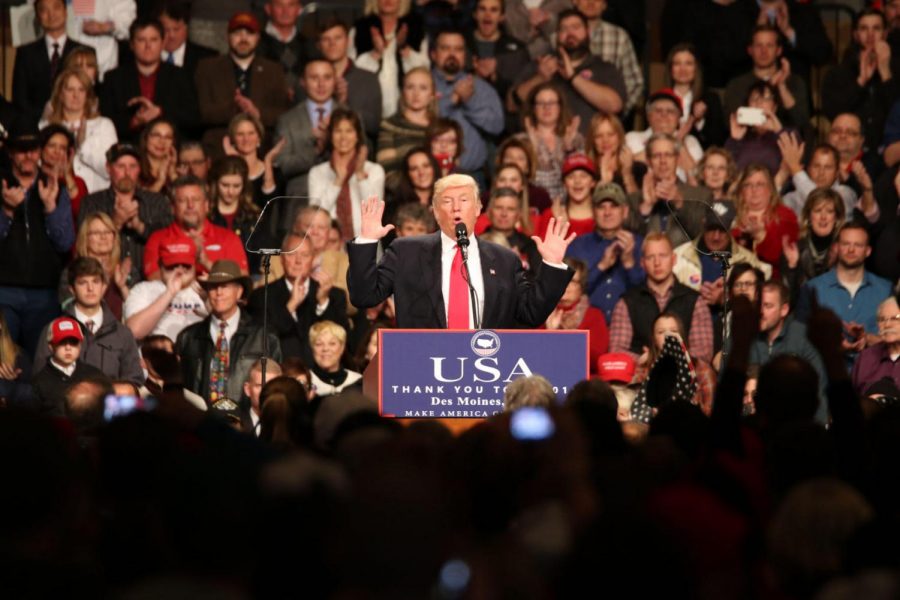Impeachment process moves forward
Courtesy of Grant Tetmeyer, NSPA Photos
President Donald Trump speaks to supporters at a rally in Des Moines, Iowa.
The U.S. House of Representatives approved articles of impeachment for abuse of power and obstruction of Congress Dec. 18, 2019, for the 45th President of the United States, Donald J. Trump, making him the third commander in chief in U.S. history to be formally impeached.
Speaker of the House Nancy Pelosi will send the articles of impeachment to the U.S. Senate Jan. 15. Only Democrats voted for passage of the articles of impeachment, the first time in history the articles were not passed by a bipartisan vote.
The House of Representatives focused their attention on a phone call between President Trump and Ukrainian President Volodymyr Zelensky, asking him to investigate Hunter Biden, the son of former Vice President Joe Biden, for Hunter’s role with the Burisma gas company. Joe Biden is a current candidate for the Democratic presidential nomination.
According to the House’s History, Art and Archives website, a government official is impeached when the House has formally charged the official with a high crime or misdemeanor by a majority vote of 51 percent. A high crime is not a felony or a misdemeanor; it is an action by an official that would be viewed as morally wrong by the American public.
After the formal impeachment process has concluded in the House, the impeachment moves to the Senate trial phase. After the articles have been passed to the Senate, Senators will be sworn in as jury members. Seven members of the House of Representatives serve as managers to prosecute their case while the Chief Justice of the Supreme Court serves at the presiding judge. After deliberations, the Senate will vote, determining if the official will be removed from office or if the official is acquitted. In order to convict the official of the accused crime, the Senate will need to pass a two-thirds majority vote of 67 percent.
On Feb. 24, 1868, President Andrew Johnson was formally impeached because he removed Secretary of War Edwin M. Stanton, which was a direct violation of the Tenure of Office Act, passed and ratified in 1867. The controversial federal law was a response to Johnson’s threats to remove Stanton from the position numerous times and stated the president could not remove a cabinet member without congressional approval. The process moved to the Senate, in which Johnson was acquitted of all charges by a margin of one vote.
Articles of Impeachment against President Bill Clinton were passed Dec. 19, 1998, almost 150 years after the impeachment of Johnson. Clinton was charged with lying under oath to a grand jury and obstruction of justice. The process began with the Whitewater Scandal, an investigation into investments made by Clinton and his wife, former Secretary of State Hillary Clinton. Although the Whitewater charges failed because of insufficient evidence, the investigation did uncover Clinton was conducting an inappropriate relationship with White House intern Monica Lewinsky. Clinton lied under oath about this relationship during a Senate Committee Hearing. Five weeks later, the Senate acquitted President Clinton with vote counts that failed to reach a majority for removal from office.
Contrary to public opinion, President Richard Nixon, was not impeached. The House Judiciary Committee started the impeachment process by introducing charges, but the House never voted on them, and Nixon was never formally charged. On July 27, 1974, the House Judiciary Committee recommended Nixon be formally impeached following the Watergate scandal. Watergate created a media frenzy and subsequently led to the resignation of Nixon from office on Aug. 9, 1974. He was never formally impeached, and President Gerald Ford pardoned him Sept. 8, 1974 for any crimes he may have committed while in office.
The length and outcome of a Senate trial in the impeachment of President Trump is still pending at this date.

Howdy! I'm Blake Loria, and I want to pursue a career in journalism, so I am honored to be serving as editor-in-chief for my third and final year on staff. As a senior, I am quite involved around Canyon High, so when I am not editing or practicing for...

Hi guys! I’m Caroline, and this is my fourth year in the journalism program and my third year writing for The Eagle's Tale. I am so excited to get back to working for the paper and writing about the wonderful people here at Canyon High as a senior....











